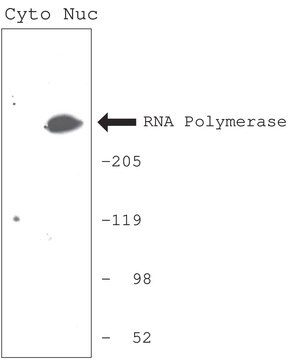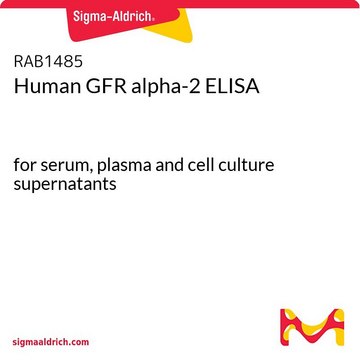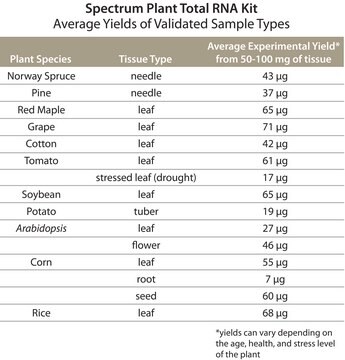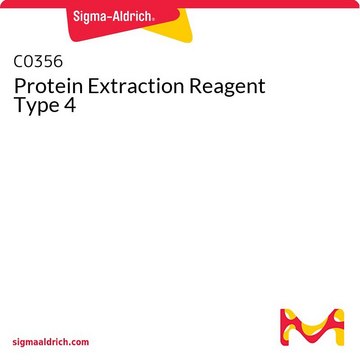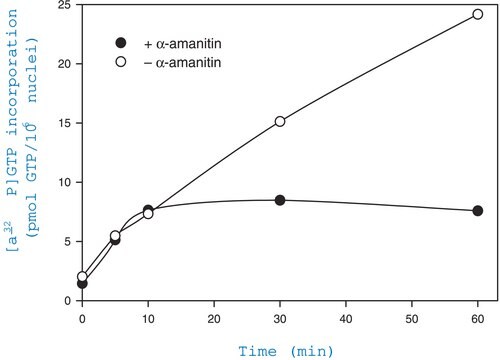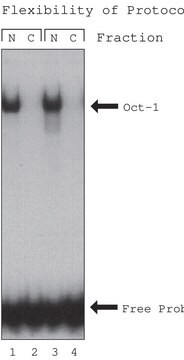PE0240
Plant Fractionated Protein Extraction Kit
Suitable for any plant species or tissue
Autenticatiper visualizzare i prezzi riservati alla tua organizzazione & contrattuali
About This Item
Codice UNSPSC:
41105500
NACRES:
NA.56
Prodotti consigliati
Descrizione generale
Sigma′s Plant Fractionated Protein Extraction Kit is designed specifically for use in plant bioscience to extract qualitative hydrophilic and hydrophobic proteins samples from any type of plant species or tissue for downstream proteomic applications. The protocol does not require any ultracentrifugation or aqueous polymer two-phase partitioning (APTP). The kit includes five reagents; a plant specific protease inhibitor, a specially formulated reagent to extract hydrophilic proteins and a new chaotropic reagent with increased solubilizing power to extract more hydrophobic proteins. Also included in the kit are reducing reagent Tributylphosphine (TBP) and alkylating reagent, Iodoacetamide. These reagents improve separation during isoelectric focusing and 2-D gel electrophoresis. The protease inhibitor is a mixture of protease inhibitors with broad specificity for the inhibition of serine, cysteine, aspartic, metalloproteases and aminopeptidases. The cocktail contains 4-(2-aminoethyl)benzenesulfonyl fluoride (AEBSF), bestatin, pepstatinA, E-64, leupeptin, and 1,10-phenanthroline.
Following removal of polyphenolics, tannins and other interfering substances, ground plant tissue, fresh or frozen, is resuspended in a specially formulated reagent to extract hydrophilic proteins. After sequential extractions of hydrophilic proteins, addition of the chaotropic reagent provided extracts hydrophobic membrane bound proteins. Plant debris is pelleted by centrifugation and protein extract solutions are collected. The end results are qualitative fractionated protein samples, ready for downstream proteomic analysis.
Following removal of polyphenolics, tannins and other interfering substances, ground plant tissue, fresh or frozen, is resuspended in a specially formulated reagent to extract hydrophilic proteins. After sequential extractions of hydrophilic proteins, addition of the chaotropic reagent provided extracts hydrophobic membrane bound proteins. Plant debris is pelleted by centrifugation and protein extract solutions are collected. The end results are qualitative fractionated protein samples, ready for downstream proteomic analysis.
I componenti del kit sono disponibili anche separatamente
N° Catalogo
Descrizione
SDS
- Plant Protein Extraction Reagent Type 1 1 bottle
- C0356Protein Extraction Reagent Type 4 1 bottleSDS
- P9599Protease Inhibitor Cocktail, for plant cell and tissue extracts, DMSO solution 3 x 1SDS
- T7567Tributylphosphine solution, 200 mM (in N-methyl-2-pyrrolidinone), liquid 3 x 0.5SDS
- A3221Iodoacetamide, Single use vial of 56 mg 3 vial(s)SDS
Avvertenze
Danger
Indicazioni di pericolo
Classi di pericolo
Acute Tox. 3 Oral - Aquatic Chronic 2 - Carc. 2 - Eye Dam. 1 - Repr. 1B - Resp. Sens. 1 - Skin Corr. 1A - Skin Sens. 1 - STOT SE 3
Organi bersaglio
Respiratory system
Codice della classe di stoccaggio
6.1C - Combustible acute toxic Cat.3 / toxic compounds or compounds which causing chronic effects
Scegli una delle versioni più recenti:
Certificati d'analisi (COA)
Lot/Batch Number
Non trovi la versione di tuo interesse?
Se hai bisogno di una versione specifica, puoi cercare il certificato tramite il numero di lotto.
Possiedi già questo prodotto?
I documenti relativi ai prodotti acquistati recentemente sono disponibili nell’Archivio dei documenti.
I clienti hanno visto anche
M Ferro et al.
Electrophoresis, 21(16), 3517-3526 (2000-11-18)
As a complementary approach to genome projects, proteomic analyses have been set up to identify new gene products. One of the major challenges in proteomics concerns membrane proteins, especially the minor ones. A procedure based on the differential extraction of
Loomis, W.D.
Methods in Enzymology, 31, 528-545 null
Wenhao Yue et al.
The Plant journal : for cell and molecular biology, 90(6), 1040-1051 (2017-02-24)
Inorganic phosphate (Pi) transporters (PTs) play vital roles in Pi uptake and translocation in plants. Under Pi sufficient conditions, PTs are degraded to prevent excess Pi accumulation. The mechanisms targeting PTs for degradation are not fully elucidated. In this study
Siew-Yong Koay et al.
Journal of chromatography. B, Analytical technologies in the biomedical and life sciences, 879(22), 2179-2183 (2011-06-22)
Orthosiphon aristatus is a traditionally used medicinal plant. In order to study the proteome of the plant, we have developed a simple plant protein extraction method by direct extraction of protein using a modified 2D-gel compatible tris-sucrose buffer followed by
Angus L Dawe et al.
Methods in molecular biology (Clifton, N.J.), 722, 225-236 (2011-05-19)
The interaction of the filamentous fungal plant pathogen Cryphonectria parasitica with its virulence-attenuating viruses provides a unique platform to explore the molecular biology and genetics of virus-host interactions. Following the development of transformation procedures for this fungus, subsequent advances include
Il team dei nostri ricercatori vanta grande esperienza in tutte le aree della ricerca quali Life Science, scienza dei materiali, sintesi chimica, cromatografia, discipline analitiche, ecc..
Contatta l'Assistenza Tecnica.
